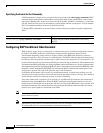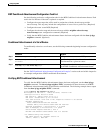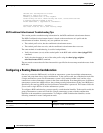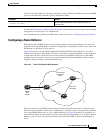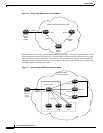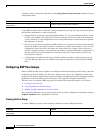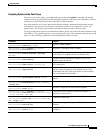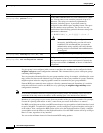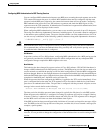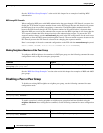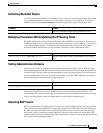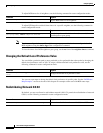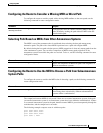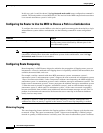
Configuring BGP
Configuring Advanced BGP Features
IPC-322
Cisco IOS IP Configuration Guide
If a peer group is not configured with a remote-as attribute, the members can be configured with the
neighbor remote-as router configuration command. This command allows you to create peer groups
containing eBGP neighbors.
You can customize inbound policies for peer group members (using, for example, a distribute list, route
map, or filter list) because one identical copy of an update is sent to every member of a group. Therefore,
neighbor options related to outgoing updates cannot be customized for peer group members.
External BGP peers normally must reside on a directly connected network. Sometimes it is useful to
relax this restriction in order to test BGP; do so by specifying the neighbor ebgp-multihop router
configuration command.
Note To avoid the accidental creation of loops through oscillating routes, the multihop session will not be
established if the only route to the address of the multihop peer is the default route (0.0.0.0).
Members of a peer group can pass routes from one member of the peer group to another. For example,
if router B is peering with routers A and C, router B can pass routes from router A to router C.
For iBGP, you might want to allow your BGP connections to stay up regardless of which interface is used
to reach a neighbor. To enable this configuration, you first configure a loopback interface and assign it
an IP address. Next, configure the BGP update source to be the loopback interface. Finally, configure
your neighbor to use the address on the loopback interface. Now the iBGP session will be up as long as
there is a route, regardless of any interface.
You can set the minimum interval of time between BGP routing updates.
Router(config-router)# neighbor {ip-address |
peer-group-name} password string
Invokes MD5 authentication on a TCP connection to a BGP
peer. You can enter a case-sensitive password of up to 25
characters. The string can contain any alphanumeric
characters, including spaces. A password cannot be
configured in the number-space-anything format. The space
after the number causes problems. You can also use any
combination of the following symbolic characters along with
alphanumeric characters:
` ~ ! @ # $ % ^ & * ( ) - _ = + | \ } ] { [ “ ‘ : ; / > < . , ?
Caution If the authentication string is configured
incorrectly, the BGP peering session will not be
established. We recommend that you enter the
authentication string carefully and verify that the
peering session is established after authentication
is configured.
Router(config-router)# neighbor {ip-address |
peer-group-name} route-map map-name {in | out}
Applies a route map to incoming or outgoing routes.
Router(config-router)# neighbor {ip-address |
peer-group-name} soft-reconfiguration inbound
Configures the software to start storing received updates.
This command requires at least one keyword. Currently the
only keyword available is inbound, so the use of inbound is
not optional.
Command Purpose



